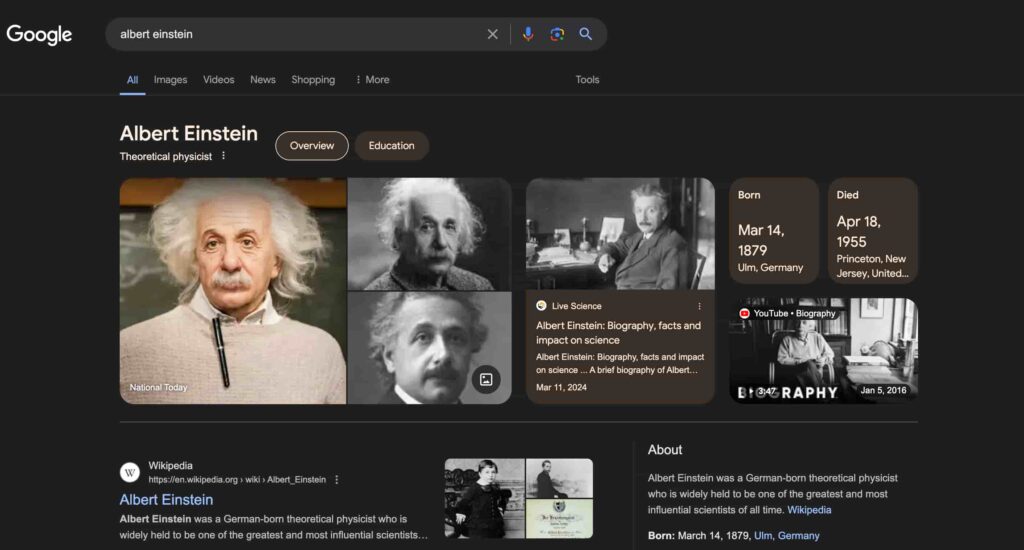How Google Search Engine Works? Beginner’s Guide

Search engines are powerful tools that help us find information on the internet. Imagine trying to find a specific book in a massive library without any help – it would be overwhelming. Search engines, especially Google, act like librarians that quickly guide us to the right section and even highlight the most relevant books.
Google is the most popular search engine in the world, used by billions of people every day. Its primary function is to help users find the information they need quickly and efficiently.
No matter if you’re looking for the latest news, a recipe, or directions to a local store, Google’s search engine is designed to provide the most relevant results in a fraction of a second.
So, How Does Google Search Engine Work?
In this guide, we’ll break down how the Google search engine works in simple terms. Even if you’ve never thought about it before, by the end of this article, you’ll have a clear understanding of the process behind those search results you rely on every day.
Google uses a combination of sophisticated technology and smart algorithms to scan, index, and rank billions of web pages. This process ensures that when you type a query into the search bar, you get the most relevant and useful results.
We’ll explain each step of this process, from how Google’s web crawlers find new content to how it decides which pages show up first in the search results.
Real-Life Example
To make this more relatable, think of Google as a very efficient librarian. When you ask a question, the librarian doesn’t just bring you any book; they bring you the most relevant and up-to-date books, articles, and papers that exactly match what you’re looking for. Google’s search engine works similarly, but on a much larger scale, scanning the entire internet instead of just one library.
By recognizing how Google’s search engine works, you can appreciate the complexity behind a simple search and learn how to make your own web pages more visible to others. This knowledge is crucial for anyone looking to improve their online presence, whether you’re a business owner, a blogger, or just someone who wants to be found on the web.
We will explore each part of this fascinating process, breaking it down step by step, so you can see exactly how Google works to bring you the information you need.
Crawling and Indexing ✅

What is Crawling?
Crawling is the first step in how search engines like Google work. Imagine you have a team of automated programs called web crawlers. These crawlers find and visit web pages across the internet. They follow links from one web page to another, just like you might follow links from one webpage to another while browsing.
Web crawlers start with a list of websites. They then explore these sites, collecting data about each page they visit. This includes details about the content, images, and links to other pages. When crawlers find new content or updates on existing pages, they add this information to the search engine’s database.
A real-life example is how you might explore a new city. You start with a map (the list of websites) and walk around, noting down interesting places (web pages) and how they connect to other places (links). Over time, you build a mental map of the city, just like web crawlers build a digital map of the internet.
Indexing Explained
Indexing is the next crucial step after crawling webpages. Once the crawlers have collected information about web pages, search engines need to organize and store this information efficiently. This process is called indexing.
Think of indexing as creating a massive library catalog. Each web page is like a book in the library. The search engine takes the data collected by the crawlers and categorizes it, making it easier to find relevant results when you search for something. This index helps search engines quickly discover and retrieve the most appropriate web pages related to your query.
For instance, when you search for “how does the Google search engine work” Google quickly scans its index to find pages that match your keywords. It looks for pages that have these words and phrases, ensuring the search results are relevant and useful.
Consider a library where books are randomly placed on shelves without any order. Finding a specific book would be chaotic. But with a well-organized catalog system, you can quickly find the book you need. Similarly, Google’s index helps users find relevant web pages swiftly and efficiently.
Sometimes content you’ve deleted or corrected online still shows up in search result previews or caches. If those outdated links linger, you can seek help requesting removal or suppression—helping ensure your current content is what users find.
Now that we understand crawling and indexing, we can move on to the next crucial part: the role of algorithms in determining which web pages appear at the top of your search results. Algorithms are like the librarians who decide which books to recommend based on various factors.
So now, let’s explore how these algorithms work and what makes some pages rank higher than others.
The Role of Algorithms
Search algorithms are the behind-the-scenes instructions that help search engines like Google decide what content to show you when you enter a query.
Think of them as the rules that guide the search engine on how to sort through billions of web pages and bring the most relevant ones to the top. These algorithms look at many factors to decide which pages best match your search.
How do algorithms determine relevance and ranking?
When you type a query into the search bar, Google’s algorithms start working immediately. They analyze your query, check their index, and rank the web pages based on various criteria. Here are some key factors they consider:
- Keywords: Algorithms look for web pages containing the keywords you used in your search.
- Content Quality: High-quality, informative content tends to rank higher. Google evaluates the usefulness and reliability of the content.
- Backlinks: These are links from other websites pointing to your page. More high-quality backlinks usually mean a page is more trustworthy.
- User Experience: Pages that load quickly, look good on mobile devices, and are easy to navigate are ranked higher.
- Engagement Metrics: If users spend a lot of time on a page and interact with it, this signals to Google that the page is useful.
Imagine you are looking for a good pizza place. You might consider several factors: how close it is, the quality of the pizza, recommendations from friends, and reviews from other customers.
Google’s algorithms do something similar but on a much larger scale, and much faster.
Google’s Algorithm Updates
Google frequently updates its algorithms to improve search results and ensure users get the best possible information. Some of the major updates include:
- Panda: Focused on improving the quality of content in search results, reducing the ranking of low-quality sites.
- Penguin: Targeted websites with spammy or irrelevant backlinks.
- Hummingbird: Enhanced the understanding of search queries and the context of the words used.
- Mobilegeddon: Prioritized mobile-friendly websites in search results.
- BERT: Improved the comprehension of the context and intent behind search queries.
Impact of these updates on search results
Each of these updates has had a significant impact on how search results are ranked. As an example, after the Panda update, websites with thin or duplicate content saw their rankings drop. The Penguin update meant that sites relying on manipulative link practices lost visibility.
Real-Life Application
Consider how product reviews influence your buying decisions. If a store gets caught faking reviews, you might avoid it in the future. Similarly, Google’s updates are like checks to ensure that only trustworthy and high-quality websites appear in top search results.
Now that you understand the role of algorithms, it’s time to look at the factors that influence which pages appear at the top of the search results. These factors, known as ranking factors, are crucial for anyone looking to improve their website’s visibility.
Let’s move forward to what makes some web pages rank higher than others and how you can optimize your web content yourself to meet these criteria.
Ranking Factors 🚀

1️⃣ On-Page SEO Factors
Content quality and relevance are crucial for ranking well on Google. When you create content, it needs to be useful, informative, and engaging. Think of it this way: if you were searching for a recipe, you’d want one that’s clear, detailed, and easy to follow. Google rewards content that meets these criteria because it provides value to users.
For example, a well-written blog post about “how does the Google search engine work” should clearly explain the process, use simple language, and provide helpful examples. High-quality content also means avoiding duplicate content and ensuring your information is accurate and up-to-date.
Role of keywords, meta tags, and HTML structure
Keywords are the words and phrases people type into the search bar. Including relevant keywords in your content helps search engines understand what your page is about. For instance, if you’re writing about how Google search engines work, use variations like “how does the Google search engine work” naturally throughout your text. Like actually, I am doing in this exact article.
Meta tags are snippets of text that describe a page’s content. They don’t appear on the page itself but in the page’s code. Important meta tags include the title tag and meta description, which help search engines and users know what your page is about. HTML structure, like using headers (h1, h2, h3), makes your content easier to read and understand, both for users and search engines.
Imagine you’re organizing a garage sale. You’d label items clearly, arrange them neatly, and ensure everything is in good condition to attract buyers.
Similarly, using the right keywords, meta tags, and proper HTML structure helps attract more visitors to your website.
2️⃣ Off-Page SEO Factors
Backlinks are links from other websites pointing to your page. They act like votes of confidence, signaling to Google that your content is trustworthy and valuable. The more high-quality backlinks you have, the higher your page is likely to rank.
Domain authority is a measure of your website’s overall credibility and trustworthiness. It’s influenced by the quality and quantity of backlinks, among other factors.
Importance of social signals and brand mentions
Social signals, like shares, likes, and comments on social media, indicate that people find your content valuable. While social signals aren’t direct ranking factors, they can boost your visibility and traffic, which can positively impact your search rankings.
Brand mentions, where your brand is talked about online without necessarily linking back to your site, also help build your site’s authority.
Think of backlinks and domain authority like word-of-mouth recommendations. If many people recommend a restaurant, you’re more likely to trust it. Similarly, Google trusts websites that have more links and are frequently recommended by other reputable sites.
3️⃣ Technical SEO
Site speed and mobile optimization
Technical SEO involves optimizing your website’s infrastructure so that search engines can crawl and index it efficiently. One critical aspect is site speed. Faster websites provide a better user experience and tend to rank higher. Tools like Google’s PageSpeed Insights can help you identify and fix speed issues.
Mobile optimization is also essential. With more people using smartphones to browse the internet, Google prioritizes mobile-friendly sites in its rankings. This means your site should be responsive, easy to navigate on smaller screens, and quick to load.
Secure and accessible websites (HTTPS, sitemaps)
Security is another key factor. Websites using HTTPS are preferred by Google because they provide a secure connection for users. If your site isn’t secure, users may see warnings that could deter them from visiting. Sitemaps help search engines find and index your pages more effectively. They’re like a roadmap of your site, showing search engines all the pages and how they connect to other pages around.
Imagine visiting a store that’s clean, well-organized, and way easier to navigate versus one that’s cluttered and confusing. You’d likely prefer the first store. Similarly, a well-optimized, fast, and secure website provides a better experience for visitors and ranks higher on Google.
Through awareness of these ranking factors is key to improving your website’s visibility. Next, we’ll look at search features and enhancements that can help you stand out even more in Google’s search results.
Things like featured snippets and the Knowledge Graph can give your content additional exposure. Let’s explore how you can leverage these tools to enhance your online presence.
Search Features and Enhancements 📝

Featured Snippets
Featured snippets are special boxes that appear at the top of Google’s search results. They aim to answer a user’s query right away by displaying a summary of the information, often extracted from a web page. These snippets can include text, lists, tables, or even videos. They are often referred to as “position zero” because they appear above the regular search results.
Specifically, if you search for “how does the Google search engine work” you might see a box at the top of the search results with a concise explanation, saving you the time of clicking through multiple links to find your answer.
How to optimize for featured snippets?
To optimize your content for featured snippets, you need to provide clear and concise answers to common questions related to your topic. Here are some steps to help you achieve this:
- Use Question-Based Headings: Structure your content with headings that match common questions users ask, like “What is a featured snippet?”
- Provide Direct Answers: Write short, direct answers immediately after these headings. Aim to summarize the answer in a few sentences.
- Use Lists and Tables: If appropriate, use bullet points or tables to present information clearly. Google often pulls these formats into featured snippets.
- Structured Data: Implement structured data (schema markup) to help Google understand your content better. This can increase your chances of being selected for a featured snippet.
Imagine you’re running a cooking blog. If someone searches “how to make pancakes” your post titled “How to Make Pancakes in 5 Easy Steps” with a clear, bullet-point list might be featured at the top, attracting more visitors to your site.
Knowledge Graph and Rich Results
The Knowledge Graph is Google’s system for enhancing search results with semantic search information gathered from various sources. It aims to provide more comprehensive answers by displaying related information in a panel beside the main search results. This panel can include images, facts, and links to related topics.
As a case in point, if you search for “Albert Einstein” you’ll see a panel on the side with a brief biography, important dates, related people, and more. This is the Knowledge Graph in action, offering a richer search experience.

Importance of structured data and rich snippets
Structured data helps search engines understand the context of your content, making it easier for them to present it in an enhanced format. Rich snippets are enhanced search results that include extra information like reviews, ratings, and images, making them more attractive and informative.
How to implement structured data?
- Schema Markup: Use schema markup to tag your content with relevant metadata. In particular, if you have a recipe page, you can use the Recipe schema to highlight ingredients, cooking time, and steps.
- Google’s Structured Data Testing Tool: Use this tool to test and validate your structured data, ensuring it’s correctly implemented.
Consider a movie review website. If you mark up your reviews with structured data, your search results might show star ratings, the release date, and a short summary directly in the search results. This makes your result stand out, increasing the likelihood that users will click on it.
You can significantly enhance your visibility in Google’s search results by understanding and leveraging search features like featured snippets and the Knowledge Graph.
Next, we’ll discuss the future of search, including the impact of voice search and artificial intelligence. These technologies are shaping how users interact with search engines and how you can adapt to stay ahead. Let’s explore what’s coming next in the world of search.
Need to Remove Information from Google’s Index?
If you find yourself needing to remove certain information from Google’s search index, it can be a challenging and technical process. Whether it’s outdated content, personal information, or any other type of data that you want removed, NonDetected can assist you.
Google sometimes indexes personal details that appear in metadata or directory listings—like your email, location, or phone. If those listings still show after you’ve removed them at the source, services are available to help erase that data from public view.
Our team of experts specializes in online reputation management and can help you get through all the complexities of removing unwanted information from Google’s search results.
Why Choose NonDetected?
- Expertise: With almost a decade of experience in online reputation management, we understand the intricacies of search engines and how to effectively manage your online presence.
- Efficiency: We use proven strategies and tools to ensure the swift and successful removal of information from Google’s index.
- Confidentiality: Your privacy is our top priority. We handle all requests with the utmost confidentiality and professionalism.
Don’t let unwanted information affect your online reputation. Reach out to NonDetected for expert assistance.
Our team is ready to help you take control of your online presence and ensure that your search results reflect the image you want to project. Now, let’s move forward to the future of search engines.
The Future of Search

Voice Search and AI
Voice search is becoming increasingly popular, thanks to smart speakers like Amazon Echo and Google Home, as well as voice assistants on smartphones like Siri and Google Assistant. When people use voice search, they tend to ask questions in a natural, conversational way. This means that SEO strategies need to adapt to this change.
By way of illustration, instead of typing “best pizza in New York” a user might say, “Where can I find the best pizza in New York?” This shift means that websites need to focus more on long-tail keywords and natural language to match the way people speak. Including question phrases and more conversational content can help your site appear in voice search results.
Role of artificial intelligence in search engine advancements
Artificial intelligence (AI) plays a crucial role in the evolution of how search engines work. Google uses AI to better understand search queries and user intent. One of the most significant AI technologies Google uses is called RankBrain. RankBrain helps Google process and sort search results, making it better at understanding the context of words and the relationships between them.
AI also helps in personalizing search results based on a user’s search history, location, and preferences. This means that two people searching for the same thing might see different results based on what Google knows about them. AI allows search engines to provide more accurate and relevant results, improving the overall user experience.
Think about how Netflix recommends shows based on what you’ve watched before. Similarly, Google’s AI learns from your searches to provide more detailed and relevant results. If you frequently search for vegan recipes, Google might show you vegan options first when you search for a recipe.
User Experience and Search Intent
Acknowledging user intent is key to providing valuable content. User intent refers to what the user is really looking for when they enter a search query.
There are generally three types of search intent:
- Informational: The user is looking for information (e.g., “how does Google search engine work”).
- Navigational: The user wants to go to a specific website (e.g., “Facebook login”).
- Transactional: The user wants to make a purchase or complete a transaction (e.g., “buy running shoes online”).
You can create content that meets their needs by realizing what users are looking for. This increases the chances that Google will rank your content higher because it directly answers the user’s query.
Enhancing user experience through better search results
Enhancing user experience is about making sure your website is easy to use, loads quickly, and provides valuable information. Google considers user experience as a significant ranking factor. Websites that are fast, mobile-friendly, and secure (using HTTPS) tend to rank higher.
One way to enhance user experience is by organizing your content clearly with headings, subheadings, and bullet points, making it easy for users to find what they need. Another way is to use images and videos to make your content more engaging.
Imagine you’re shopping online. If a website is slow to load or hard to navigate, you’ll probably leave and find another site. Google wants to prevent this by promoting websites that offer a good user experience. A fast, well-organized site with clear, helpful information is more likely to keep users engaged.
Even after deleting the content where an image was originally published, it may still appear in Google Images—or as a cached thumbnail. If unwanted visuals continue to surface, there’s help available to request removal from Google images results.
With an understanding of the future of search helps you stay ahead of the game. Voice search, AI, and a focus on user intent and experience are shaping how users interact with search engines. By adapting to these changes, you can ensure your content remains relevant and visible.
Wrapping Up
In this guide, we’ve covered how search engines, especially Google, work to provide relevant results for your queries. We started by discussing the basics of website crawling and indexing, explaining how web crawlers discover new and updated web pages and how this information is organized in a search index.
We then moved on to the role of algorithms, detailing how search algorithms determine the relevance and ranking of web pages based on various factors, such as content quality, backlinks, and user experience. We also touched on Google’s frequent algorithm updates and their impact on search results.
Next, we explored ranking factors, including on-page SEO (like keywords and meta tags), off-page SEO (such as backlinks and social signals), and technical SEO (focusing on site speed and mobile optimization). Knowing these elements is crucial for improving your website’s visibility.
We also discussed search features and enhancements, such as featured snippets and the Knowledge Graph, explaining how they provide quick, comprehensive answers to users’ queries and how you can optimize your content for these features.
Lastly, we looked at the future of search, highlighting the growing importance of voice search and artificial intelligence in search engine advancements, and the critical role of understanding user intent and enhancing user experience.
Search engines are constantly evolving, driven by advancements in technology and changing user behaviors. Staying updated with these changes is essential for anyone looking to maintain a strong online presence.
As search engines become more sophisticated, focusing on providing high-quality, relevant content and ensuring a positive user experience will continue to be the cornerstone of successful SEO strategies.


